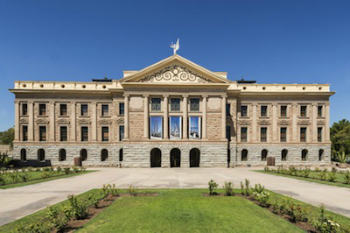
Overview of Arizona Taxes
The state of Arizona has relatively low property tax rates, thanks in part to a law that caps the total tax rate on owner-occupied homes. The average effective tax rate in the state is 0.56%, which is well below the 0.90% national average.
| Enter Your Location Dismiss | Assessed Home Value Dismiss |
| Average County Tax Rate 0.0% | Property Taxes $0 (Annual) |
| of Assessed Home Value | |
| of Assessed Home Value | |
| National | of Assessed Home Value |
- About This Answer
To calculate the exact amount of property tax you will owe requires your property's assessed value and the property tax rates based on your property's address. Please note that we can only estimate your property tax based on median property taxes in your area. There are typically multiple rates in a given area, because your state, county, local schools and emergency responders each receive funding partly through these taxes. In our calculator, we take your home value and multiply that by your county's effective property tax rate. This is equal to the median property tax paid as a percentage of the median home value in your county.
Arizona Property Taxes

The typical Arizona homeowner pays just $1,786 in property taxes annually, saving them over $1,000 in comparison to the national average. Property taxes in Arizona are paid in two semi-annual installments, one due on Oct. 1 of the current tax year and another due on March 1 of the following year.
How Arizona Property Taxes Work: Limited Property Value
A handful of numbers are used to calculate the property tax due on each piece of real estate in Arizona. The first is the current cash value of your home. Arizona counties calculate a full cash value of every house in the county, often based on the sales prices of nearby, comparable homes.
Taxes are not based on the full cash value, however, but something called the Limited Property Value (LPV), which is based on cash value. It cannot exceed the cash value of the home and is further limited in how much it can increase each year. A law passed by Arizona voters in 2012 states that the LPV can increase by no more than 5% from one year to the next. This limits tax increases in times when home values are increasing quickly.
Tax rates are applied to assessed values. The assessment ratio for residential property in Arizona is 10%. That means assessed values are equal to 10% of the LPV.
A financial advisor can help you understand how homeownership fits into your overall financial goals. SmartAsset’s free tool matches you with up to three vetted financial advisors who serve your area, and you can interview your advisor matches at no cost to decide which one is right for you. If you’re ready to find an advisor who can help you achieve your financial goals, get started now.
Arizona Property Tax Rates
Property tax rates in Arizona vary according to certain factors, such as your city, county, school district and whether your house is in any special tax districts. There are two types of tax rates: primary and secondary. Primary tax rates fund government entities like municipalities and school districts, while secondary tax rates fund special districts and bond issues for major projects. Primary rates usually account for the majority of property tax rates in Arizona.
Tax rates are calculated each year by taxing authorities depending on their funding needs and the tax base. That means rates can change annually. However, for owner-occupied homes, the total primary tax rate between all districts is limited to 1% of the property’s limited value. If your total rate exceeds that amount, your school district taxes will be reduced and the state will cover the difference.
Even homeowners whose tax rate is lower than the 1% limit receive a benefit from the state if they live in their house. In this case, owner-occupied residences receive a Homeowner Rebate of 40% of school taxes, up to $600 per year. This rebate, and the 1% cap mentioned above, keep property taxes in Arizona relatively low. The table below shows effective property tax rates in every county in Arizona.
Want to learn more about your mortgage payments? Check out our mortgage payment calculator.
Maricopa County
The largest county in Arizona, Maricopa County, is home to the city of Phoenix and surrounding cities like Mesa, Chandler and Glendale. The average effective tax rate in the county is just 0.51%. Rates vary by city and school district, though.
Pima County
Property tax rates in Pima County are the second highest of any county in Arizona. The average effective property tax rate in Pima County is 0.84%. That is higher than the state average, and the typical Pima County homeowner pays $2,161 annually in property taxes, which is also above average statewide.
Pinal County
The average effective property tax rate in Pinal County is 0.58%. That's above average for Arizona, but well below the national average. It means that a homeowner with a home worth $200,000 can expect to pay about $1,160 annually in property taxes.
Yavapai County
Located north of Phoenix, Yavapai County is home to the city of Prescott, as well as numerous National Forests and wilderness areas. The county offers residents abundant natural beauty, and low property tax rates. The average effective property tax rate in Yavapai County is just 0.47%.
Mohave County
Across the U.S., Mohave County is the fifth-largest county in terms of area. It also has some of the lowest property taxes. The median annual tax payment in Mohave County is just $1,196, which is about $700 less than the state average. The average effective property tax rate in the county is 0.51%.
Yuma County

Located in the southwestern corner of Arizona, alongside the Mexican and Californian borders, Yuma County has property tax rates that are above the state average. The average effective property tax rate in Yuma County is 0.73%. With a county median home value of $173,500, that means the average homeowner in Yuma County pays $1,266 annually in property taxes.
Coconino County
Coconino County, which covers the north central portion of Arizona, has the highest median home value of any county in the state at $299,100. So, although the average effective tax rate is relatively low, at 0.63%, actual payments are among the highest in the state. The typical Coconino County homeowner pays $1,899 annually in property taxes. That, however, is still well below the national average of $2,795.
Cochise County
Cochise County sits in the southeast corner of the state of Arizona, along the borders with New Mexico and Mexico. The county has tax rates that are close to state averages, but they vary depending on where you live and, even more so, by school district. Cities in Cochise County charge primary rates, which means that they cannot exceed a total of 1% for owner-occupied properties when combined with city and county rates.
Navajo County
The typical homeowner in Navajo County pays $1,082 annually in property taxes, less than half the national average. That is in part because of the county’s relatively low home values. The median is just $165,600. Even taking that into account, however, rates are quite low. The average effective tax rate in Navajo County is 0.65%.
Apache County
If you are in search of an area with low taxes on real estate, look no further than Apache County. The median real estate tax payment is now $522, which is a sixth of the national median.

